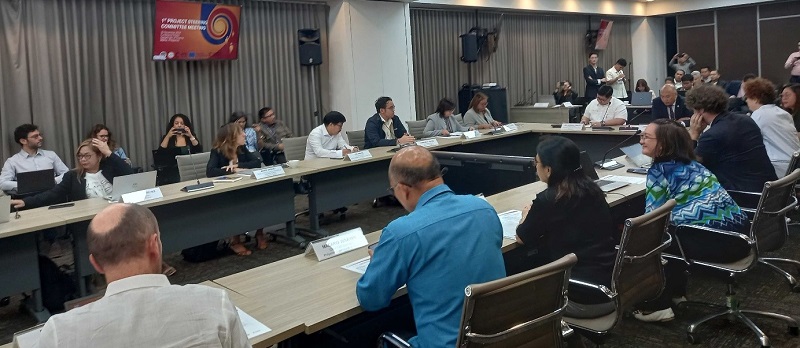

With about 18 to 20 typhoons per year, the archipelago of the Philippines is particularly exposed to natural hazards and vulnerable to the impacts of climate change. In 2022, 2023 and 2024, the Philippines was ranked as the most disaster-prone country in the world (World Risk Index)
Over the past decade, the Philippine government has developed a national risk reduction policy, which recognizes the central role of Local Government Units (LGUs). In this perspective, LGUs need to be supported in strengthening their technical capabilities in terms of understanding risks and adapting their territory and human organization.
 The French Development Agency (Agence Française de Développement - AFD) has been running cooperation programmes with this country since 2009. Combining loan, technical support and public policy dialogue, AFD supports and accelerates the implementation of priority policy and institutional reforms to mitigate and adapt to climate change.
The French Development Agency (Agence Française de Développement - AFD) has been running cooperation programmes with this country since 2009. Combining loan, technical support and public policy dialogue, AFD supports and accelerates the implementation of priority policy and institutional reforms to mitigate and adapt to climate change.
In this context, a technical cooperation partnership has been defined between AFD, Cerema and the government of the Philippines. The contribution of CEREMA is expected to focus on three types of activities:
- Flood simulations and mapping
- Risk-based urban planning
- Sharing international experience.
A two-week mission to meet national and local stakeholders
A Cerema team formed by Marc IGIGABEL (Project Director), Hassan SMAOUI (Research Director) and Sylvain Lendre (Design Engineer) went on a mission to the Philippines between 15 and 30 November 2024 to better assess the cooperation needs, to produce recommendations in terms of knowledge of the hazard, adaptation of territories and institutions.
The meteorological context has been marked by an unprecedented succession of typhoons. Between 21 October and 16 November 2024, in four weeks, the Philippines experienced a series of six consecutive tropical systems (i.e. typhoons and storms), including 3 super typhoons (cf. Figure 1).

Finally, during the mission carried out between 15 and 30 November 2024, CEREMA met its partners from the DILG and the DoF, AFD, EF (cf. Figure 2), as well as seven national agencies involved in risk management, and 4 Local Government Units subject to high flood and/or landslide risks.

Visit and consultation of Local Government Units

Four LGUs were consulted during the mission: Tuguegarao City (north of the main island of Luzon), Talisay (50 km south of Metro Manila), Makati City and Quezon City (two cities in Metro Manila).
The Cerema delegation was warmly welcomed in Tuguegarao City by the municipal technical services, at the end of crisis management after the flooding caused by the overflow of the Cagayan river (cf. Figure 3) and its tributary, the Pinacanauan river. This flood was generated by the supertyphoon Man-Yi which caused very heavy rainfall upstream of the watershed, the week before our visit.
The Cerema delegation also visited Talisay, located in the caldera of the Taal volcano.
Damages are due to intense rainfall, strong currents, widespread flooding, and especially landslides (cf. Figure 4) responsible for the death of 20 persons. Floodwaters reached 3 feet (about 1 meter) in some areas during the last typhoon. The flooding brought mud and debris, exacerbating its effects.

Continuous rains over 36 hours, compounded by debris from the Taal Volcano eruption in 2020, led to extensive flooding and infrastructure damage. Floodwaters partially buried homes and vehicles and disrupted economic activities for days.
Finally, the delegation from Cerema visited Makati city, located in the heart of Metro Manila.
The most problematic situations, as well as more exemplary arrangements (cf. Figure 5) were studied.

Field visits to Tuguegarao City, Talisay and Makati City led to initial recommendations for reducing risks and impacts on the environment.
Mission’s conclusions on the development of cooperation
The mission’s conclusions on the development of cooperation are as follows:
- In the short term, the most relevant activity would be to carry out a large-scale hydraulic model on the flood prone area of Metro Manila (about 15 million inhabitants). This model could be refined on Makati City, for the adaptation of its drainage system to the evolution of land use (soil sealing) and the effects of climate change (increase in rainfall over short periods).
- In the longer term, other actions may be considered based on the results of the hydraulic modelling on Metro Manila:
- development of another large-scale model on Tuguegarao City to better understand river overflow phenomena on a mixed urban/rural site;
- expertise for adaptation of the territories of the pilot sites;
- participation in high-level public policy dialogue to adapt the organization and governance;
- workshop to present the cooperation actions carried out with pilot sites to other local authorities;
- participation in study visits organized for Filipinos in France.

